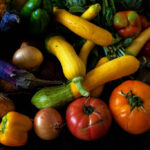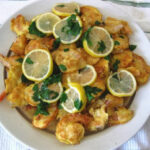In October 2013, I fell head-over-heels in love with the Italian region of Emilia-Romagna.
In April 2014, I had the opportunity to extend that romance a little westward…still in Emilia-Romagna…to the great city and province of Piacenza.
Emilia-Romagna’s a big place, and, lordy, covering it all would take a long time. For example, on neither trip did I go into the eastern part of the region, the part known as Romagna, which extends out to the Adriatic Sea and includes such spectacular cities as Ravenna and Rimini.
No, I’ve been sticking for the last six months to the western half, Emilia—which itself is pretty damn big. And mind-blowingly delicious.
Emilia has a string of five well-known cities that run northwest to southeast along the fertile Po River valley (which gives the region so much of its character—like grazing flatland cows, and milk, for such products as Parmigiano-Reggiano and Grana Padano).
The most southeast of Emilia’s Big Five cities is the most famous one, Bologna. But as you work your way northwest on A1 (a major autostrada), you pass Modena (home of balsamic vinegar), then Reggio nell’Emilia, then Parma (home of you-know-whats), before you come to #5, the historic city of Piacenza.
Piacenza, perhaps, is at a little bit of a disadvantage, PR-wise, compared to the other four. Most pertinently, it does not have a famous gastronomic product tied to it in the international imagination.
But that’s no reason for tourists…or eaters…or drinkers!…to ignore it.
First of all, founded by the Romans in 218 BC, it is a lovely city, quite small…but with a big history. Lying at a crossroads between the Alps-oriented Lombards of the north, and the riches of eastern Italy, Piacenza (a major stopping point on the Via Aemilia) is a city that has been incredibly wealthy (particularly in the Middle Ages, for its abundance of cereal and dairy), and incredibly contested (with many armies attempting to gain control here). All of this is writ large in Piacenza’s castles, forts and palaces, which make the city and region a treasure trove for history buffs.

A sign for one of Piacenza’s best wineries, set in an historic castle, right on the road that divides Lombardy from Emilia-Romagna
But there is a special kind of feeling here, that overcomes the grandeur of history: it is a real place. Its wealth today is made, believe it or not, by tomatoes; here in the Piacenza region, in northern Italy, more tomatoes are grown and canned as sauce than anywhere else in Italy. And as one of my guides made sure to tell me, snickering at the much more famous lands of Tuscany: “here, land is owned by farmers, by real people. In Tuscany, land is owned by big industry. Here, quality control is done by men, not machines. Here, the farmers spend more time with their crops than they do with their bankers.”
You can feel it in the food.
This being Emilia, the food of course is spectacular. As I wrote in October, I believe that this part of Italy has the best food in the whole country. And you will find in Piacenza many of the themes that play out so deliciously around Bologna, and the rest of Emilia. But the food to me, on my short trip, seemed a little more “country” here, a little more relaxed and informal.
As testimony, I offer one of Piacenza’s most prized products, perhaps the greatest source of local pride: salumi! The specialties in Piacenza (though many kinds of salumi are made) are coppa, pancetta, and salame. Here’s the pile-up that was offered to me on my first day, at one of Piacenza city’s finest restaurants:
Sublime! And here’s me at lunch at Peveri Salumificio, with the salumi factory’s owner:
Hot tip: The world-famous culatello, now made only in Zibello, near Parma (currently not allowed in Piacenza!) was actually born on the Piacenza side of the Po (they have the ancient documents to prove it)…and there is a movement to create a new DOP, Culatello di Piacenza. Look for it!
In the Piacenza region, coppa—which comes from the pig’s neck—is not always a cured meat. At the finest restaurant I visited, Castello di Luzzano (also a great winery), the main course was a fantastic stack of thin, uncured coppa slices in a soulful gravy, anchored by delicious local greens:
Very Piacenza.
Another great food that’s very popular in Piacenza is gnoccho…which, last October, I devoured in Parma, Modena, and Bologna. It is basically a fluffy, savory pastry, deep-fried, that comes with prosciutto draped over it. But in Piacenza, draping’s a little too fancy…so they just serve the fatty pork on the side, and leave it to you to tear open your own gnoccho.
Of course, this is a grand region for pasta as well—particularly the stuffed pasta that they call tortelli. It is always home-made egg pasta, stuffed with ricotta and spinach (plus grated cheese), usually served with butter and sage. But every restaurant—and every mama!—has a different touch on it. Here are three different versions in Piacenza restaurants:
A very particular local pasta dish, that you will not find elsewhere, is Pisarei e Faso…basically a local version of pasta fazool!
However, beans though there are, it is not exactly pasta—it is made with bread dumplings, fashioned from leftover bread! The whole dish is a beautiful example of Piacenza’s soulful, rustic style.
Of course, no discussion of this region would be complete without a mention of Parmigiano-Reggiano’s chief rival…Grana Padano!
The two cheeses are made practically next door to each other (in some cases, on the opposite sides of a small stream!!), and they are more alike than they are different. But there is fierce competition between them…with the more famous Parmigiano-Reggiano always getting the higher price, and usually getting the critical praise. Typical for Piacenza. Their grating cheese, Grana Padano, is also wonderful…and maybe even more flexible in its gastronomic uses!
The flavor of Grana Padano is like the flavor of Parmigiano-Reggiano…but milder, more subtle. That means that Grana Padano does not overwhelm its ingredient-mates in a dish; often, it’s the better choice! I tasted some three-year-old Grana Padano from the great caseificio Lattegra that was both subtle and profound…and produced in a sustainable way!
Finally, however, the jewel in the crown of Piacenza is its wine. In the whole world, there is not a region that makes better wine for everyday drinking, by real people, with real food…that is as unknown as Colli Piacentini!
This translates as the hills of Piacenza…and these low, up-and-down collines sit southwest of the city of Piacenza, in a lovely, gentle, natural setting—lovely to tour, lovely to stay in. Someday, as the wines become better known, wine geeks may classify the sub-regions in the Colli Piacentini—as there are four major rivers (not wide) that flow through the hills, creating what the locals think of as four distinct microclimates for wine. It was all too much for me, on my first visit; I wasn’t picking up the microclimatic differences very strongly, so I decided to focus on other things.
I suppose the first thing to know about Colli Piacentini wines is that there are 16 DOCs granted by the Italian government…but not a single DOCG, the more “serious” designation! To me, this is a wonderful thing. This is not a region where the world is caught up by the likes of Barolo, or Brunello di Montalcino, or Amarone. Those kinds of 100-point wines, paradoxically, are not for real wine-lovers in many senses. Loaded with tannin, alcohol, and wood, they are usually very difficult to drink in their early years. Wine publications don’t really tell you this, so we poor Americans think that drinking a 2009 Barolo right now is the thing to do. Unless I have to, I will not drink any 2009 Barolos this year. In fact, I don’t want to drink any Barolos, or Brunellos, or Amarones this year that are not at least TWENTY years old. Oh, then I’m good. Wines like these, when well-made, can age magnificently—but to drink them before they’ve aged is to commit infanticide, as well as palate aggression. In their regions, real wine-drinkers look for other, less “serious” wines to get them through on an everyday basis. They are out there, and they can be delicious.
But what happens when a region has no “flagship” DOCG blockbusters? Then…the winemakers, and the wine-drinkers, focus on the region’s “simple” wines, bringing them to heights of everyday excellence not usually found in the more “famous” regions.
Such a place is Colli Piacentini.
As I mentioned, there are 16 DOCs in this region—and because 14 of them can be made in several different styles, it gets real confusing real fast (another reason, perhaps, why wine drinkers outside of Italy haven’t dug in yet to this subject). So I decided, on my trip, to focus on three DOCs only—the ones that create, in my experience, the best of the Colli Piacentini wines. And, not surprisingly, the ones that have gotten the most attention in other parts of Italy.
(Dave’s little prayer: may they come here too, and improve the quotidian wine life of the American wine-drinker!)
Here’s the sassy Piacentini trio:
ORTRUGO
The first glass of wine I was handed at my first meal in Piacenza (at Antica Osteria del Teatro) was a fizzy white Ortrugo. Ortrugo? I had to confess to my host that I had never ever even heard of this wine! It turns out to be the region’s most important white grape variety, yielding mostly fizzy wines that are right on my radar: crisp, dry, a little stony/minerally, much better than most of the non-Champagne plonk being proffered around the world. It is the name of the grape variety, but also the name of the wine—almost always sparkling, rarely still. For the rest of my trip, I always looked forward to that opening glass of Ortrugo! But there are two slight complications in it:
1) A bottle of Ortrugo must contain at least 90% Ortrugo grapes; the rest (if the winemaker chooses to use others) may be drawn from a variety of other Emilia-Romagna white-wine varieties
2) Ortrugo is usually sparkling. It can be frizzante, which is to say lightly sparkling…or it can be spumante, more sparkling. I encountered some producers who took the latter through the more expensive Champagne production method, hiking up the price of the wine. For the moment: I think I’m an Ortrugo Frizzante guy.
GUTTURNIO
So here’s the first big twist in the local wine logic: Gutturnio is NOT a grape variety! But it is the ubiquitous red wine of Piacenza.
As you can see from the label, it is frizzante—dark, bubbly, dry red! Sound familiar? It is not unlike the dry Lambrusco that everyone drinks all the time further east in Emilia (Modena is a huge Lambrusco center). However, the Gutturnio Frizzantes from the Colli Piacentini (compared to Lambrusco) often have a little more stuffing to them, if that floats your boat. Why? Grape varieties. Gutturnio is made from Barbera (usually 70%, but officially 55% to 70%), and Bonarda (usually 30%, but officially 30% to 45%). Please note that the latter grape variety is not the same as Argentina’s Bonarda, which makes a pretty light wine in South America. The Bonarda here, locally known as Croatina, adds a deep color and considerable fruit to the blend.

Frizzante Gutturnio, like the fizzy red Vinho Verde of northern Portugal, is sometimes drunk in a white porcelain bowl…like this one, reflecting the brick ceiling above in a regional cellar
But it gets more complicated. The DOC Gutturnio (with the same regulations for grape varieties), can also be applied to a dry, still red wine (called Gutturnio Superiore)…
to a more serious dry still red from a delimited area (called Gutturnio Classico Superiore)…
to a serious dry still red held longer at the winery (called Gutturnio Riserva)…
and to the most serious of the dry still reds, held back two years AND from the delimited region of the Colli Piacentini, (called Gutturnio Classico Riserva).
As you can tell, I LOVE the Gutturnio Frizzante wines with food! But I also tasted many a fine dry still red called Gutturnio:
*fairly young for body and force
*medium-age (4-5 years) for gathering elegance
*older (ten years) for complexity
COLLI PIANCENTINI MALVASIA
This DOC is pretty confusing as well…because there are FOUR styles of Malvasia wine within the DOC…AND…there’s another DOC entirely that can use Malvasia (called Colli Piacentini Vin Santo).
Nevertheless, it is worth staying on top of this one. Why? Quite simply…because the wines are delicious! Sometimes dry, sometimes sweet, sometimes still, sometimes fizzy…but always with that mesmerizing flowery Malvasia aroma which, I quickly point out, is more subtle than, say, Muscat aromas.
The aroma here is so special because of the Malvasia sub-variety they use in the Piacenza region. There are 16 sub-varieties of Malvasia across Italy, but the original (from Greece, eons ago) is called Malvasia di Candia Aromatica. Believe it or not: the Colli Piacentini is the only place in all of Italy that grows Malvasia di Candia Aromatica! Of the Piacentini Malvasia variations, my favorite is the dry Frizzante—which goes gorgeously with salumi, particularly prosciutto! Ain’t bad with asparagus, either…
And it’s worth mentioning the Vin Santo that’s made here from Malvasia di Candia Aromatica—though producers have other options of grape variety for Vin Santo. But according to one of my guides—bashing Tuscany again!—”the famous Tuscan Vin Santo is made from non-aromatic grape varieties. When they make it in Piacenza from the very aromatic Malvasia di Candia Aromatica—wow! What a difference!” And from the tasting I did…I totally agree.
SOME COLLI PIACENTINI WINES I ESPECIALLY LIKED ON MY TRIP
This could be an exercise in frustration for you, because the vast preponderance of these wines are not available in the U.S. But keep looking: you never know! Also, if you take my advice and head to Piacenza for a gastronomic journey…keep these great wines in mind!
2013 Ortrugo Frizzante, Rio Magreto, Montesissa
Light, dry, fresh, fizzy, from the best all-around producer I tasted in Colli Piacentini.
2013 Gutturnio Frizzante, Il Poggiarello
Gorgeous purple, lovely fizz, effusive fruit, bone-dry.
2011 Gutturnio Classico Superiore, Montesissa
Medium body, dry, still, so supple, hints of almonds and other aged flavors. Great Italian restaurant wine!!
2003 Gutturnio Riserva, Podere Casale
This is a special wine, from a special winery. Podere Casale is owned by the spirited, utterly charming Daniela Carugati—who also runs a tranquil, very comfortable agro-turismo at the winery (it’s where I stayed most nights), in the small town of Vicobarone. One night at dinner, Daniela proudly brought out this wine, a wine with a story. Her husband Angelo died in the spring of 2003–leaving mother and son (Nicola) to face the hot 2003 harvest by themselves. They rose to the occasion, and made this beautifully balanced red, which, at almost 11 years old, is today showing gorgeous leathery-truffly tertiary aromas. It is proof of the aging potential of Gutturnio—and of the power of love!
NV Boccadirosa, Luretta
A still white made from Malvasia di Candia Aromatica. Acacia notes, complex. A gorgeous balance of a little sugar and great acidity. If you’re interested in Malvasia di Candia Aromatica, you should visit this estate at a great castle in Gazzola: I tasted through a dozen Malvasias, of all ages and styles, because the winemaker is obsessed with the variety. The charming thing is: he doesn’t feel he’s gotten it right yet with this grape. It has enormous potential—and he feels he will be the one to create the Malvasia di Candia Aromatica style from Piacenza that the world notices! I agree with his vision: Malvasia di Candia Aromatica ain’t just another floral grape.
NV Malvasia Fermo, La Ciocca
Crisp, lily-scented, just off-dry still Malvasia from one of the best modern winemakers in Colli Piacentini.
So…. I’m a dreamer. In this case, I’m dreaming about a day when Piacenza assumes its rightful stature as a great wine destination, and a great tourist destination in general. Of course, the latter dream may be deleterious to this unspoiled place—as evidenced by this sign that went up recently in downtown Piacenza:
I don’t think the hamburgers and the hot dogs will ever take over…but go now! Or soon! Just to be sure!
GREAT PLACES TO STAY IN THE PIACENZA AREA
Podere Casale
www.poderecasale.it
Locanda Villa Tavernago
www.villatavernago.it
Castello di Rivalta
www.castellodirivalta.it

















